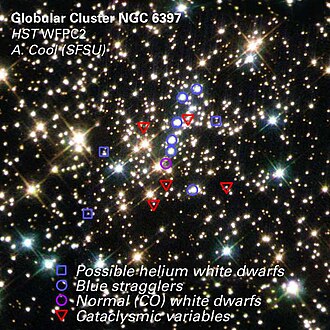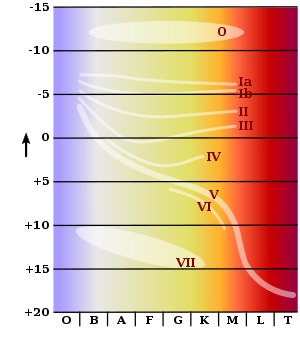Blue straggler
A blue stragglers (more common English term: Blue straggler ) is a star , the blue (hot) and more luminous than a star the same age and the same metallicity .

analysis
According to the theory of stellar evolution, all stars in the Hertzsprung-Russell diagram are arranged along a line, the main sequence, according to their age and mass . Blue stragglers appear to contradict this theory in that they are beyond the main sequence.
Blue stragglers were initially noticed in star clusters in which all stars emerged from a homogeneous molecular cloud at the same time . In the meantime, blue stragglers have also been detected in the galactic bulge , in the halo of the Milky Way and in dwarf galaxies .
An analysis of the characteristics of blue laggards can be done via:
- their pulsations . Many blue stragglers lie in the Hertzsprung-Russell diagram in the instability strip of the dwarf cepheids . These variable stars form a pattern of vibrations, the analysis of which by means of asteroseismology enables an analysis of the star structure and thus also of the development.
- their speed of rotation , which is often quite high compared to other stars of apparently the same age. This rapid rotation can be demonstrated by the rotation broadening in the spectral lines . In the case of an outer convective layer, the rapidly rotating blue stragglers show all signs of stellar activity such as radioflares , x-ray emission and photometric variability through star spots . The FK-Comae-Berenices stars are likely the products of a merger of a close binary star system .
- possibly their variability in coverage . In the case of blue stragglers, which have arisen through a mass transfer in a close binary star system, the mass donating companion can be observed through radial velocity measurements or, with suitable orientation in space, as an eclipsing star. In both cases it is possible to derive the absolute parameters and thus the evolution of the binary star system.
Formation variants
Mass transfer in binary stars
If stars in binary star systems have different masses, their development takes place on different time scales. The more massive star depletes the hydrogen supply in its core more quickly by burning hydrogen and developing into a red giant . If it expands beyond the Roche limit , matter subsequently flows to its companion with less mass. The expanding star gets out of balance and continues to expand, increasing the transfer of matter. As a result, the lower-mass companion becomes the more massive star (blue straggler), which is orbited by the core of the formerly massive star, a low-mass white dwarf . Such binary star systems could be detected by the NASA satellite Kepler .
Star mergers
A second mechanism of formation is necessary because blue stragglers also occur as single stars. Close contact systems are assumed to be the forerunners of these blue stragglers. In binary star systems like W-Ursae-Majoris , the orbits of the two stars run in a common envelope . They lose angular momentum through gravitational radiation and magnetic interaction and merge into an extremely fast rotating single star. Much energy is released during this merging, and this event is known as the Luminous Red Nova or mergeburst . In the case of the luminous red Nova V1309 Sco, the cover light change of the contact system could be measured before the fusion.
In triple systems, the orbits can also be unstable in the long term due to the Kozai effect or Darwin instability and lead to a merging of the central binary star system.
Star collisions
About 1% of all stars in open and globular clusters are blue stragglers. Particularly in the dense centers of globular clusters, some of the blue stragglers may have been created by collisions. If the relative speed between the stars involved is not very high, only a few percent of the atmosphere is lost in the collision and there is no intermingling of the stars. The spectra of blue stragglers do not show any chemical composition that would be typical for a mixing of two stars.
The blue laggards from collisions also include close encounters between a star and a binary star system, whereupon the orbit parameters of the binary star system change. Should the orbital distance in the binary star system decrease, this can lead to a long-term blue lag as a result of a mass transfer.
Occurrence in globular clusters

The distribution of the blue stragglers in globular clusters is characterized by a high concentration in the core, a subsequent zone of avoidance (engl. Zone of Avoidance ) and a back increased concentration in the outer region of the cluster. This is interpreted as a consequence of two different creation mechanisms in the core and in the outer area of the pile or as a result of dynamic friction . Here, in a close encounter of a blue straggler with another star kinetic energy transferred to the less massive star, she goes to the by definition lost more massive blue straggler. As a result, it sinks deeper towards the center of the star cluster and increases the concentration there.
If the blue stragglers of a globular cluster are plotted in a color-brightness diagram , then two main series can be seen:
- a blue row, in which no variability is observed by changing the covering light. The blue sequence is interpreted as blue stragglers that emerged from collisions, where two stars with almost identical mass merge.
- a red row of which approximately 50 percent of the members belong to the eclipsing W-Ursae-Majoris stars . The red row is formed from the mass transfer in tight double stars, with the high proportion of red coming from the mass donating companion.
The dynamic effects make it difficult to determine the proportions of the development mechanisms. However, spectroscopic studies show a companion in up to 75% of all blue stragglers in globular clusters due to variations in radial velocity. Therefore, in globular clusters, a mass transfer in close binary star systems is likely to be the dominant formation mechanism for blue stragglers.
Red and yellow stragglers
In addition to the blue stragglers, red and yellow stragglers are also found in globular clusters and open star clusters. In the Hertzsprung-Russell diagram, these stars lie between the break point at which the stars develop from the main sequence in the direction of the giant branch and the giant branch. They are brighter than the normal sub-giants of the star cluster. They could be former blue stragglers who, due to their higher mass, cover a bright path of development to the giant branch. Alternatively, it could also be an unresolved binary star system or superimposition of constellations .
The red stragglers are also referred to as sub-sub-giants due to their location in the HR diagram . They are often the brightest X-ray sources in the star clusters with a luminosity of 10 31 erg / s, which is interpreted as a sign of coronal activity, and are probably always members of binary star systems.
Examples
- 40 Cancri , single blue straggler in Messier 44
- 47 Tucanae , globular clusters with blue stragglers
- Tau Scorpii , blue straggler visible to the naked eye
Web links
- Special Stars: Astronomical Curiosities , by Jürgen Kummer at Google Books
Individual evidence
- ↑ A. Weigert, HJ Wendker, L. Wisotzki: Astronomy and Astrophysics: A basic course . 5th revised and expanded edition. Wiley-VCH, Weinheim 2009, ISBN 978-3-527-40793-4 .
- ^ William I. Clarkson et al: The First Detection of Blue Straggler Stars in the Milky Way Bulge . In: Astrophysics. Solar and Stellar Astrophysics . May 22, 2011, arxiv : 1105.4176v1 .
- ^ Mario Matteo: Photometrically variable Blue Straggler . In: Astronomical Society of the Pacific Conference Series . tape 53 , 1993, pp. 74-96 .
- ↑ A. Unsöld, B. Baschek: The new cosmos: Introduction to astronomy and astrophysics . 7th revised and expanded edition. Springer Verlag, Berlin 2006, ISBN 3-540-42177-7 .
- ↑ R. Di Stefano: TRANSITS AND LENSING BY COMPACT OBJECTS IN THE KEPLER FIELD: DISRUPTED STARS ORBITING BLUE STRAGGLERS . In: The Astronomical Journal . tape 141 , no. 5 , 2011, p. 142–152 , doi : 10.1088 / 0004-6256 / 141/5/142 .
- ↑ Ealeal Bear, Amit Kashi, Noam Soker: Mergerburst Transients of Brown Dwarfs with Exoplanets . In: Astrophysics. Solar and Stellar Astrophysics . 2011, arxiv : 1104.4106 .
- ↑ R. Tylenda, M. Hajduk, T. Kamiński, A. Udalski, I. Soszyński, M. K Szymański, M. Kubiak, G. Pietrzyński, R. Poleski, Ł Wyrzykowski, K. Ulaczyk: V1309 Scorpii: merger of a contact binary . In: Astrophysics. Solar and Stellar Astrophysics . November 1, 2010, arxiv : 1012.0163 .
- ↑ Benjamin J. Shappee, Todd A. Thomson: THE MASS-LOSS INDUCED ECCENTRIC Kozai MECHANISM: A NEW CHANNEL FOR THE PRODUCTION OF CLOSE COMPACT OBJECT STELLAR BINARIES . In: Astrophysics. Solar and Stellar Astrophysics . 2012, arxiv : 1204.1053v1 .
- ↑ Alison Sills: Blue Straggler Formation in Clusters . In: Astrophysics. Solar and Stellar Astrophysics . 2010, arxiv : 1009.2033v1 .
- ↑ E. Dalessandro, FR Ferraro, D. Massari, B. Lanzoni, P. Miocchi, G. Beccari, A. Bellini, A. Sills, S. Sigurdsson, A. Mucciarelli, L. Lovisi: Double Blue Straggler sequences in GCs : the case of NGC 362 . In: Astrophysics. Solar and Stellar Astrophysics . 2013, arxiv : 1310.2389v1 .
- ^ Nathan Leigh, Alison Sills, Christian Knigge: An Analytic Model for Blue Straggler Formation in Globular Clusters . In: Astrophysics. Solar and Stellar Astrophysics . 2011, arxiv : 1105.5388 .
- ↑ L. Lee Clark, Eric L. Sandquist, Michael Bolte: The Blue Straggler and Main-sequence Binary Population of the Low-Mass Globular Cluster Palomar 13 . In: Astrophysics. Solar and Stellar Astrophysics . 2004, arxiv : astro-ph / 0409269v1 .
- ↑ Maureen van den Berg: X-ray sources in Galactic old open star clusters . In: Astrophysics. Solar and Stellar Astrophysics . 2012, arxiv : 1211.6133 .
